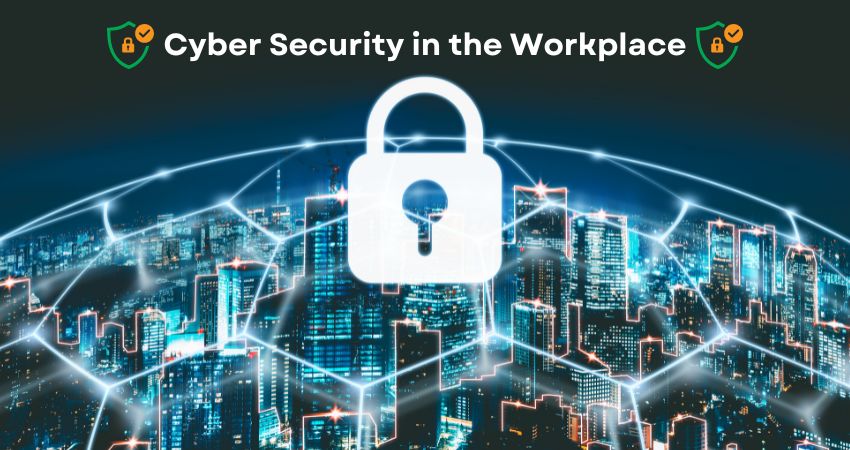Table of Contents
- Introduction
- 1: Understanding Workplace Cybersecurity
- 2: Building a Strong Cybersecurity Foundation
- 3: Best Practices for Cybersecurity
- 4: Incident Response and Recovery
- 5: Continuous Improvement and Monitoring
- FAQs
- What is the importance of cybersecurity in the workplace?
- What are the best practices for employee training in cybersecurity?
- How can we protect against phishing attacks and other common cyber threats?
- What should we include in our cybersecurity policies and procedures?
- How can we create a cybersecurity culture within our organization?
- Conclusion
- Read More Article
Introduction
In today’s digital age, workplace cybersecurity is paramount. With the surge in cyber threats and attacks, safeguarding sensitive data, customer information, and reputation has become a top priority for organizations. In this comprehensive guide, we’ll delve into the best practices for cybersecurity in the workplace, offering actionable steps to fortify your organization’s defenses.
1: Understanding Workplace Cybersecurity
What is Workplace Cybersecurity?
Workplace cybersecurity encompasses the strategies and measures organizations employ to protect their digital assets, including data, systems, and networks. It’s a holistic approach aimed at ensuring the confidentiality, integrity, and availability of information.
The Current Cyber Threat Landscape
The world of cyber threats is rapidly evolving. We’ll take a closer look at the latest cyber threats impacting workplaces, including ransomware attacks, phishing schemes, and data breaches. Understanding these threats is crucial for implementing effective countermeasures.
2: Building a Strong Cybersecurity Foundation
Creating a Cybersecurity Culture
Fostering a cybersecurity-conscious culture within your organization is pivotal. We’ll explore how to nurture an environment where employees grasp the significance of cybersecurity and actively contribute to its success.
Establishing Robust Policies
The cornerstone of any effective cybersecurity strategy lies in clear and comprehensive policies. We’ll outline the key policies that every organization should have in place and elucidate their importance.
Employee Training and Awareness
Often, employees serve as the first line of defense against cyber threats. In this section, we’ll delve into the significance of ongoing employee training and provide practical tips for boosting awareness regarding cybersecurity best practices.
3: Best Practices for Cybersecurity
Access Control and Password Management
Effective access control mechanisms and prudent password management are integral components of cybersecurity. Discover best practices for limiting access to sensitive data and maintaining robust password security.
Data Encryption
Data encryption is the linchpin for protecting information in transit and at rest. Learn about encryption methods and how to integrate them to secure your organization’s valuable data.
Regular Software Updates and Patch Management
Outdated software is a prime target for cybercriminals. We’ll elucidate why keeping your software current through updates and employing effective patch management is pivotal for cybersecurity.
Secure Remote Work Practices
The surge in remote work has introduced fresh cybersecurity challenges. Gain insights into how to secure remote work environments while preserving productivity without compromising security.
4: Incident Response and Recovery
Preparing for Cyber Incidents
No organization is impervious to cyberattacks. Having a well-structured incident response plan in place is indispensable. Explore the key elements of a robust plan and understand why proactive preparation is paramount.
Steps to Take During a Cybersecurity Incident
In the event of a cybersecurity incident, swift and effective action is essential. We’ll delineate the necessary steps to undertake during an incident, including communication and reporting protocols.
Post-Incident Recovery and Evaluation
Recovering from a cybersecurity incident involves a multifaceted process. Uncover how to evaluate the extent of damage, retrieve lost data, and conduct a post-incident analysis to fortify your security posture.
5: Continuous Improvement and Monitoring
The Role of Cybersecurity Audits
Routine cybersecurity audits play a pivotal role in identifying vulnerabilities and weaknesses. We’ll expound upon the significance of these audits and elucidate the steps required to conduct them effectively.
Ongoing Threat Monitoring
Cyber threats are perpetually evolving. Continuous monitoring is indispensable for detecting and responding to new threats promptly. Explore the tools and techniques available for vigilantly monitoring your organization’s security landscape.
FAQs
What is the importance of cybersecurity in the workplace?
What are the best practices for employee training in cybersecurity?
How can we protect against phishing attacks and other common cyber threats?
What should we include in our cybersecurity policies and procedures?
How can we create a cybersecurity culture within our organization?
Conclusion
In closing, workplace cybersecurity is an ongoing commitment that necessitates vigilance and dedication. By implementing the best practices outlined in this guide, your organization can significantly reduce its vulnerability to cyberattacks and safeguard its sensitive data. Remember that cybersecurity is a collective responsibility, and staying informed and proactive is the key to maintaining a secure workplace environment. Take action today to bolster your organization’s defenses and ensure a safer digital future.
Read More Article
Secure Your Business Data with These Proven Methods – Data Security Solutions
Cyber Threats Uncovered: Are You at Risk?
Cyber Security Trends: What’s Hot in 2023
Cyber Hygiene: A Daily Routine for Online Safety

